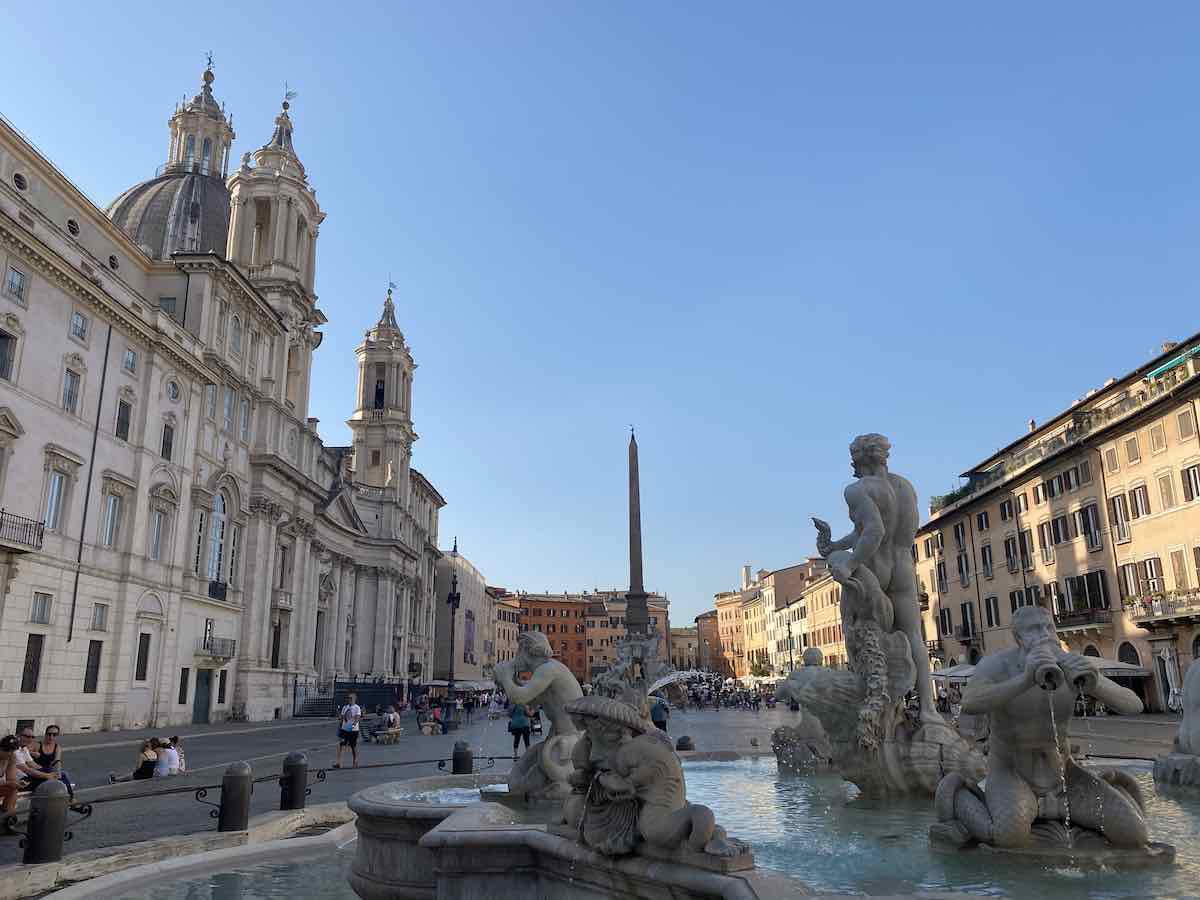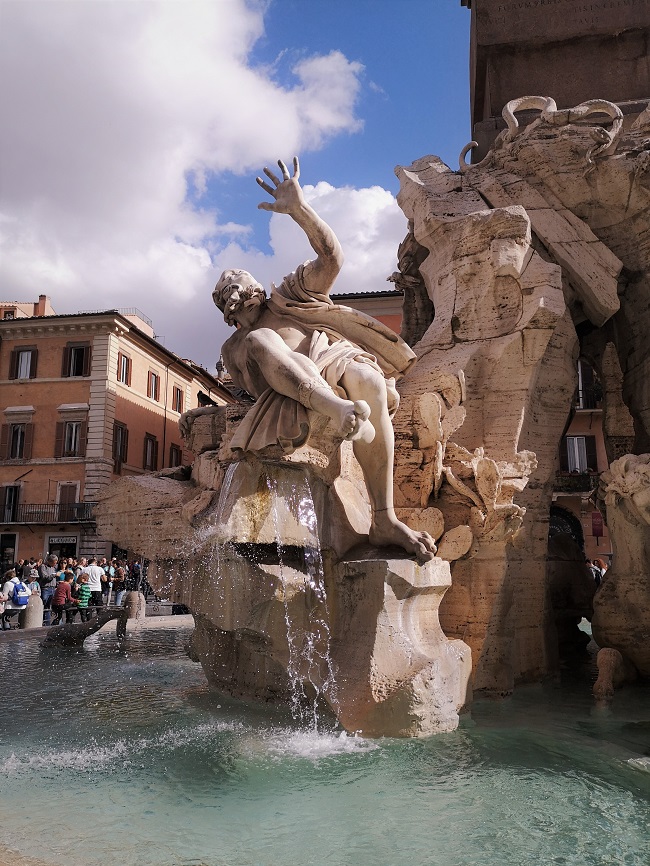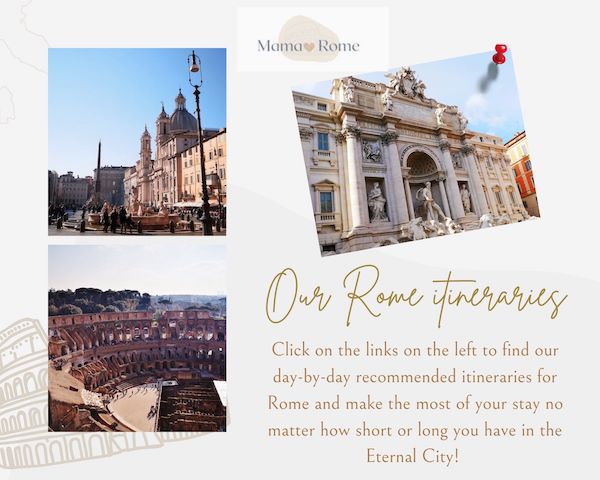Travel Guide to Piazza Navona Rome. All you need to know to visit the famous Piazza Navona: facts about Piazza Navona, stories and tips for visiting.
Piazza Navona is one of the most famous squares in Rome if not the most famous of all.
It is the piazza in Rome with fountains and obelisk that you see in so many movies set in Rome and it is in real life even more beautiful than the silver screen may suggest.

Grand, elegant, iconic and full of history, it is a place that features in all Rome itineraries and that I highly recommend to seek out even if you just have one day in Rome.
It is so beautiful and iconic it is a Rome must-see site
But what is so special about Piazza Navona, what there is to see and how can you get there? I answer these and many more questions in this visitors’ guide to Piazza Navona.
Rome – the city of visible history, where the past of a whole hemisphere seems moving in funeral procession with strange ancestral images and trophies gathered from afar.” – George Eliot, novelist
Find more quotes about Rome here
Piazza Navona is so breathtaking, it is one of the top 10 Rome attractions all visitors should see.
Piazza Navona Facts Chart
| Address | Piazza Navona, 00187 Rome |
| Neighborhood/ District | Rione Parione |
| Size | 275 mt x 106 mt |
| Built | I century AD as Stadium of Domitian |
| Designed to current appearance | XVII century |
| Main architect / architects | Gian Lorenzo Bernini / Francesco Borromini |
| Main Client | Pope Innocence X Pamphili |
| Most Famous Sights | Fountain of the Four Rivers, Church of Santa Agnese in Agone, Fontana del Moro (Fountain of the Moor), Fontana del Nettuno (Fountain of Neptune) |
| Cost of visit | Free |

Please note: this post contains affiliate links and, should you make a purchase through them, we might make a small commission.
Fun and interesting facts about Piazza Navona
What is Piazza Navona? Why is Piazza Navona famous?
Piazza Navona is a large, historical square (piazza) in the center of Rome.
Piazza Navona is famous for several art masterpieces by well-known artists such as Bernini and Borromini, which make it one of the most important Baroque squares in the world.
They decorated the square with a breathtaking church and one of the most beautiful fountains in Rome: the Fountain of the Four Rivers, one of the most famous and photographed in the city.
The piazza is also famous for its peculiar history, which started in the times of the Roman Empire and also for being the stage of many legends (see below).
Is Piazza Navona Free to visit?
Yes, access to Piazza Navona is free.
Piazza Navona is a public square and therefore is free to access and always open.
When was Piazza Navona built?
Piazza Navona was built in 86AD.
The history of Piazza Navona starts in the I century AD, when Emperor Domitian decided to build a new stadium for chariot races and naval battles.
He identified the area of what we now know as Piazza Navona as the most suitable and proceeded to create a large, impressive stadium, not entirely dissimilar in shape to Circus Maximus.
While the square went through many changes over the centuries, it is still possible to see the original shape and plan of the circus: stand anywhere in the piazza and pay attention to its elliptical shape, the long straight sides and the rounded ends.
That’s Domitian’s circus, in front of you!
How big is it?
Piazza Navona is 270 mt long and 55 mt large. It has an oval shape.
When in use as a stadium, it would have hosted up to 33,000 spectators.
What was Piazza Navona used for?
Despite its beginning as a chariot stadium, the piazza changed scope and use over the centuries, becoming a popular market square and an area for hosting public events and celebrations.
Fun fact about Piazza Navona: until the XVIII century, the piazza used to get flooded, on purpose, and turned into a lake for leisure activities! You can see pictures of this in Palazzo Braschi, the museum of Rome overlooking the piazza.
What does Navona mean?
The name ‘navona’ probably comes from the corruption of the Latin word ‘in agone’ (agone=competition, race).
When this piazza was the stadium of Domitian, it was a space for games, in Latin a ‘circus agonalis’ and places in the square would be referred as being ‘in agone’.
As Latin developed and transformed, in agone eventually became ‘navona’, a more familiar word that became the official name of the piazza.
Fun fact: The church of Santa Agnese that overlooks the square is still called Santa Agnese in agone, to distinguish it from another Santa Agnese ‘Fuori Le Mura’, which is a different church outside of the center.
What movies filmed here?
Many movies set in Rome have at least one scene here: Eat, Pray, Love, La Grande Bellezza, The Talented Mr Ripley are some of the most famous US movies filmed here but the list is long!
Where is Piazza Navona and how to get there?
Piazza Navona is in Rome city center, in the Rione Parione district.
It is close to several other important landmarks in Rome such as Campo de’ Fiori (just across the road) the Pantheon (less than a 5 minute walk), Piazza Venezia and the Vittoriano (10 min away) and the Trevi Fountain (less than a 15 min walk).
Piazza Navona is also close to Castel Sant’Angelo, about a 10 minute walk away on the other side of the river.
You can reach Piazza Navona on foot from all these attractions or you can get one of the many buses running along Corso Vittorio Emanuele II.
Some of the best bus routes serving this area are 30, 60, 62, 81, 87.
Map of Piazza Navona
A brief history of Piazza Navona
Piazza Navona has a fascinating history.
The piazza was initially commissioned to be built in 80 AD but wasn’t a piazza. Instead, it was a stadium!
Good to know! If you look at the piazza from above or even just walk along its perimeter, you can still see its oval shape. The stadium/piazza has two long parallel sides and two shorter, semicircular ones that create the shape of a racing course.
Over the course of the centuries, however, the use of this space changed and we have documents showing how in the XV century the square hosted the market and became the go-to place for processions and public events.
In the XVI century, Pope Gregorio XIII ordered the construction of 3 fountains here, which included a water hole for the horses and the animals who would bring produce to the market.
In the XVII century, Pope Innocent X ordered the embellishments that we still see nowadays: the sculpture adorning the Fountains and then the building of the church of Santa Agnese.
Despite these significant architectonical interventions, the square still stayed as an important public space and we have documents showing it transformed periodically into a lake, for the joy and entertainment of the population!
What there is to see in Piazza Navona
These are several things worth seeing in Piazza Navona.
The piazza itself
Piazza Navona opens up for the visitor without warning.
You stroll around Rome’s famous cobbled streets and, suddenly, you find yourself in this large, open-air space expanding for hundreds of meters in front of you (275 x 55 meters, to be precise)!

The visual impact on the visitor is always strong and this is why I believe the piazza itself, even before you dig into its architectural gems, is worth a visit.
The best time to visit is the early morning, before 10 am, and the night, when the lights make it grand yet intimate, imposing yet welcoming.
The Fountain of the four rivers (La Fontana dei Quattro Fiumi)
Piazza Navona has 3 fountains, the most famous of which is the so-called ‘Fontana dei Quattro Fiumi’ in its center, by Gian Lorenzo Bernini.
The fountain towers in the center of the piazza and has an interesting story.

In 1651, Pope Innocenzo X Pamphili decided to redo the square in front of his palace and announced a competition for artists to submit their best ideas.
Gian Lorenzo Bernini wanted the job but due to his problematic relationship with the current Pope, he decided to go about it in an unusual way.
Rather than waiting for the official competition, he built a miniature model of his own proposed fountain, molded it in silver and made sure to get it delivered to Donna Donna Olimpia Maidalchini Pamphili.
She was the sister in law of the Pope and, they said, the real power behind the Pamphili Pontificate.
Romans knew her as La Pimpaccia and Pasquino, the famous talking statue of Rome, often had witty remarks about her.
Rome gossip tells us that this present of silver got the attention of Donna Olimpia who convinced the Pope to assign the work to Bernini.
He is indeed the one who designed the fountain as we see it now: the only later addition to his design is the obelisk on top.
The fountain represents the 4 biggest rivers in the world each in human form: the Nile, the Gange, the Rio de la Plata, and the Danube.

Maybe the most impressive of all is the Nile, whose head is covered to symbolize the unknown source of its waters.
The fountain is one of the most beautiful in Rome and a true work of art. Its figures are so exquisitely carved, they are among the most famous sculptures in Rome.
Find here >>> fun and interesting facts about the Fountain of the Four Rivers by Bernini.
Church of Santa Agnese in Agone
Just in front of the fountains towers the beautiful church of Sant’Agnese in Agone, designed by architect Borromini.
The church is said to date back to the VIII century but it was rebuilt several times and acquired the current look in the XVII century, when Pope Innocenzo X gave architect Rainaldi and then Borromini the job to redesign its facade.
It was completed between 1653 and 1657.
The church of Santa Agnese in Agone is a Baroque masterpiece.
The decor is incredibly elaborate, with the typical use of gold and colorful marbles typical of the era, and it also hosts the relic of the skull of St Agnes Martyr, hosted in one of the churches’ crypts.
Santa Agnese was killed in Piazza Navona and her death is reported as preceded by miraculous events.
Agnese was a young Christian girl at a time when Christianity was banned in Rome and fell victim of the Christian prosecution by Emperor Diocletian in the IV century AD.
Only 13 years old, Agnes was first exposed in Piazza Navona and this is when the first miracle is said to happen: a man looking at her nude body lost his sight, fulminated on the spot!
To protect her body and her modesty, her hair also grew miraculously, enveloping her entirely.
When put on the stake, the flames spared her and her prosecutors ended up using a sword at her throat, as if she was a lamb (incidentally, the name Agnes is associated with the elating Agnus, lamb, as in Agnus Dei).
Both the church and the crypt are free to visit: please remember that modest attire is required when visiting churches in Rome.
You can find here >>> out expert tips on how to dress in Rome

Fun fact! Bernini and Borromini were rivals for the Pope’s favors and Romans have attached this rivalry also to the statues in Piazza Navona. They say that the statue representing Rio de la Plata is covering his eyes because he is terrified the church may collapse on him, while the statue of Santa Agnese on the church has her hand on her heart to reassure him of the church stability!
This legend about two of the most famous sights in the piazza is fun but untrue.
The fountain was built before the church and the position of the figure representing Rio de la Plata has a much more interesting and symbolic explanation: the fear of the wealthy (the river: plata in Spanish means silver) to suddenly lose their riches and power (the serpent, at the basis of the statue).
Other Piazza Navona Fountains: Fontana del Moro and Fontana del Nettuno
Along the two smaller sides of the square sit two more fountains, both by Giacomo Dalla Porta: Fontana del Moro and Fontana del Nettuno.
Fontana del Moro (Fountain of the Moor) is at the southern end of the square and takes water from the Virgo Aqueduct.
It was built in the XVI century by Giacomo della Porta and later incorporated designs by Bernini, who added to it the muscular male figure that gives the fountain its name.
The fountain represents the male figure of a Moor and tritons. You can read a description and facts about the Fountain of the Moor here.

Fontana del Nettuno is at the northern end of the square, close to a road that used to host makers of pots and pans, reason why for a long time people referred to it as ‘Fontana dei Calderari’.
Like the Moor Fontain, it first commissioned to Giacomo della Porta by Pope Gregory XIII in 1574 and takes its water from the Virgin Aqueduct, which the Pope reopened.
The Fountain represents the Roman God Neptune fighting with an octopus, surrounded my marine creatures.

They are both beautiful and also are at the center of a very special event that used to take place between 1652 and 1886: the turning of Piazza Navona into a lake!
The careful flooding of Piazza Navona happens for the first time in June 1652 and quickly became a favorite city event that brought all layers of Rome society together.
This tradition stopped when Rome became the capital of Italy: at this time the whole square got covered in cobbles and redesigned in such a fashion that water can no more be contained. This is a shame as it sure must have been fun!
While this tradition has now stopped, the square is still a place for entertainment: street artists (and vendors) flock here and over, Christmas, the square still hosts the city’s most famous Christmas market.
Palazzo Braschi
One of the most interesting buildings overlooking Piazza Navona is Palazzo Braschi, now hosting the museum of Rome.
This is a stunning building with impressive ceilings and interesting old photos of the city, including a reconstruction of the Trevi fountain made of cork!
The museum is worth visiting and it also has stunning views over the piazza from its 3rd floor.
Palazzo Doria- Pamphili
Palazzo Doria-Pamphili is now the seat of the Brazilian Embassy in Rome and one of the most beautiful historical palazzos in the city.
The palace was built in the XVII century by Girolamo Rinaldi by order to Pope Innocent X Pamphili and became Papal residence, which explains the many beautiful frescoes and elegant interiors of this palazzo.
Visiting Piazza Navona with kids
Piazza Navona is one of the easiest historical locations to visit in Rome with kids in tow.
The square is large and car fee, absolutely perfect for running around, and has something special: a wonderful toy shop aptly called Al Sogno (The Dream), with life-size teddy bears in its window (they have giraffes, bears, crocodiles: it is an incredible place for kids)!
On the opposite end of the Piazza, you also find Vivi Bistrot, which is a family friendly restaurant on the piazza with reasonable prices (for the location) and

Hotels near Piazza Navona, Rome
Piazza Navona is an enviable location to call home in Rome. Several good hotels are in the area including these are the best hotels near Piazza Navona.
Eitch Borromini, luxury, a stunning property with an equally stunning rooftop terrace with views over the Piazza
Palazzo Navona a modern, beautiful hotel in an enviable location to explore the whole of Rome city center
Navona 49 Suites, beautiful rooms overlooking the square.
You can find here >>> our complete selection of the best hotels near Piazza Navona here.
Where to eat near Piazza Navona: restaurants and cafes
Piazza Navona attracts many tourist which has a negative impact on the prices and quality of some of the meals you get in this area.
There are, however, good restaurants and cafes’.
Some I enjoy are:
Cul de Sac, relaxed wine bar/ bistrot in Piazza Pasquino
Vivi Bistrot, relaxed bistrot in the patio of Palazzo Braschi
Gelateria del teatro, in one of the side streets, serving great gelato
Mr 100 Tiramisu, Via dei Sediari, serving some of the best tiramisu in Rome
You can find these and more food addresses in our guide to Rome for foodies
Not sure how to include this attraction in your Rome itinerary? Check our Rome itinerary suggestions below:
Rome in a day: detailed Rome city centre itinerary for first time visitors
Rome in two days A detailed itinerary for two full days in Rome
Rome in three daysRome in four days – day-by-day 3 day Rome itinerary
Rome in five days – complete Rome itinerary with main attractions and less usual sites for visitors with more time in the city
Traveling to Rome with kids? Find our family guide to Rome here.

Safe Rome travels!
